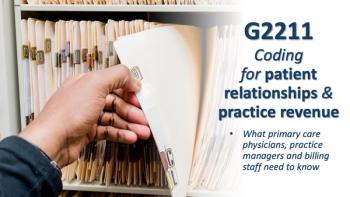
4 ways to prepare for MACRA in 2019
Revenue cycle management tips to enhance cash flow under the 2019 Quality Payment Program Final Rule.
The new year is fast approaching, and practices must keep pace with evolving Medicare Access and CHIP Reauthorization Act of 2015 (MACRA) policies. With the new final reporting rule, it is often difficult to balance optimizing the revenue cycle while monitoring impacts on performance scores and operational workflows.
To combat these challenges, practices can apply the following four tips to enhance cash flow while being mindful of MACRA’s Merit-based Incentive Payment System (MIPS) reporting requirements:
Prepare for major changes for MIPS Year 3. MIPS participation eligibility changes with MACRA’s Quality Payment Program (QPP)
To be exempt from MIPS Year 3 participation, clinicians or groups must meet one of the following three criteria:
- Have $90,000 or less in Part B allowed charges for covered professional services,
- Provide care to 200 or fewer Part B beneficiaries, or
- Provide 200 or fewer covered professional services under the Physician Fee Schedule (PFS).
The third exemption option is new in MIPS Year 3. In addition, clinicians or groups who meet these exemption criteria can now voluntarily participate if they meet one or two low-volume threshold MIPS exemptions. For exempted clinicians, the opt-in option was not available in past years, which prevented them from reaping MIPS reimbursement through properly documented and submitted category measures.CMS also offers the option for clinicians who are based at a healthcare facility to use facility-based scoring instead of reporting separately.
In terms of overall performance category changes, the transition from MIPS Year 2 to Year 3 brings slight category weight shifts. The Quality category will account for 45 percent, Cost for 15 percent, Promoting Interoperability (PI) for 25 percent and Improvement Activities (IA) for 15 percent. This places a higher focus on the Cost category in 2019.
Additionally, participating clinicians must adjust to the reallocation of the small practice bonus in 2019, available for practices with 15 or fewer eligible clinicians. Now, the small practice bonus offers up to six points rather than the five that were available in 2018. And unlike last year, the points will be added to the numerator of the Quality performance category score, rather than the overall MIPS final score. Still, in MIPS Year 3, CMS will continue to award small practices three points for submitted Quality measures that do not meet data completeness requirements. Finally, clinicians should look out for new MIPS terms throughout the Year 3 final rule, such as collection type, submitter type, and submission type. The terminology change better reflects how clinicians and vendors interact with MIPS.
Strategize MIPS performance category submissions. Both the MIPS PI, formerly Advancing Care Information, and IA categories expanded in 2018 and adjusted reporting activity options to ease meaningful participation for more practices. Many practices do not realize they can submit IA measures for any continuous 90-day reporting period. In demonstrating improvement to existing activities for easy comparison and documentation, 2018 MIPS participants should thoroughly document IA starting points and activity measurement progress as well as take advantage of opportunities.
Within the newly named
2015 CEHRT is required in MIPS Year 3. It is no longer a bonus opportunity, and 2014 CEHRT will not be permitted in MIPS Year 3. The 2019 final rule eliminates the old PI bonus opportunity and scoring method to focus instead on performance-based scoring at the individual measure level.
Ensure more conscientious registration processes. As administrative and business office staff juggle multiple roles, physician practices suffer from a high rate of denied claims. To improve claims processing without pulling significant time from MIPS and other value-based care reporting, require registration or appointment staff to collect accurate insurance data, including for Medicare and managed care plans.
Have staff verify this information for all scheduled encounters at least one week prior to the appointment. At appointment check-in, ask staff to check for expired patient identification and insurance cards using a formalized basic registration checklist. Host training throughout the year for new hiresand conduct annual staff re-education with visual examples of checklists and workflows for proper registration data collection. Repeated attention to insurance data details can significantly impact claims processing success, which can free up more time for staff to focus on MIPS initiatives.
Encourage patient portal participation. Clinicians often do not encourage patients to use patient portals for test results, secure communication, and payments. Yet increasing portal adoption is an easy way to score MIPS PI points, improve patient satisfaction, and free staff from answering calls. Automated portal notifications and consistent communications with patients around portal access, for example, touch PI measures in areas like secure messaging, patient-specific education, and patient access.
Patient portal adoption has also been shown to improve care plan adherence among patients with chronic conditions and save staff time. For private insurance collections, the ability to accept payment directly from the patient portal reduces staff follow-up efforts and days in accounts receivable. Therefore, practices should remind patients at check-in and again at check-out to utilize their portal access. Provide patients with private login credentials and short, clear instructions to promote adoption rates. Promote patient portal utilization with each patient visit and include material explaining its benefits in patient waiting rooms.
Fully comprehending the evolving MACRA changes can be extremely difficult for already strained practice staff. By following these four recommendations, practices can improve their collections and documentation workflows, maximize reimbursement opportunities, and improve practice operations significantly.
Joncé Smith is vice president of revenue cycle management for
Newsletter
Optimize your practice with the Physicians Practice newsletter, offering management pearls, leadership tips, and business strategies tailored for practice administrators and physicians of any specialty.








